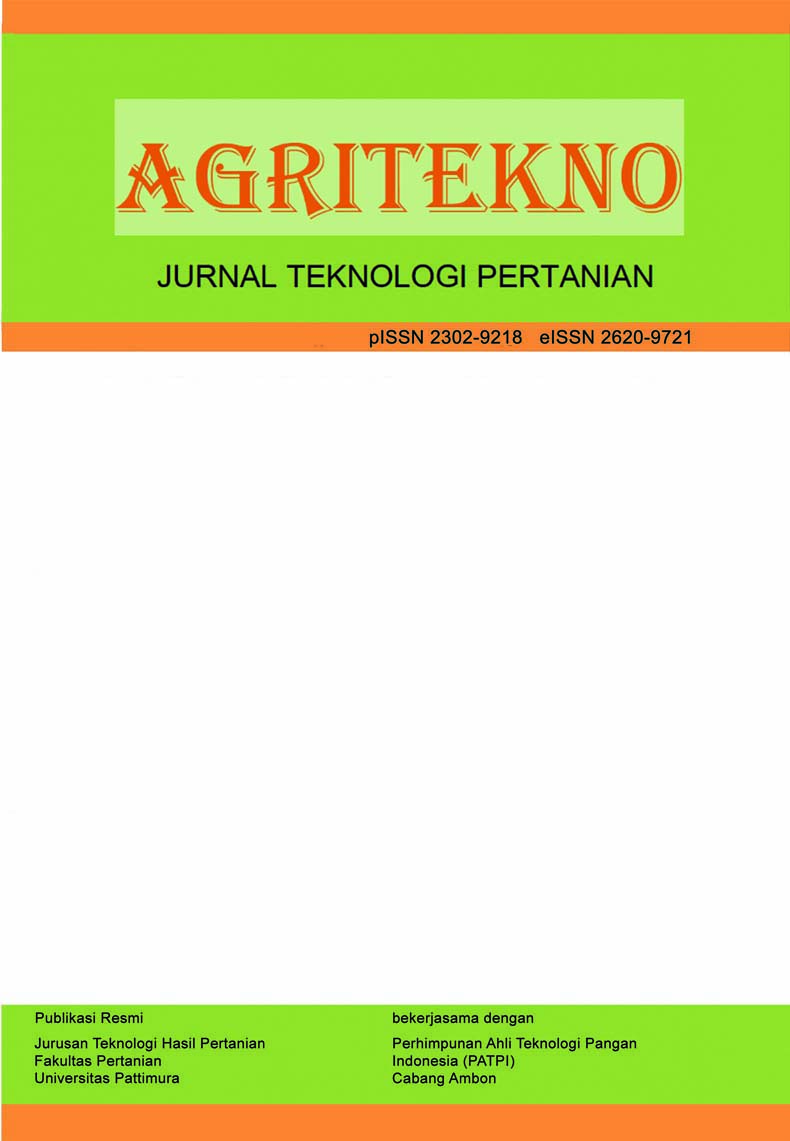Biskuit Bebas Gluten menggunakan Bahan Baku Tepung Mocaf dan Blondo
Gluten Free Biscuits Using Mocaf Flour and Blondo Ingredients
Abstract
This study evaluated the effects of substituting modified cassava flour (mocaf) with blondo coconut oil on the moisture, fat, protein, carbohydrate, and ash content of gluten-free cookies. A completely randomized design with a one-factor arrangement was applied, consisting of five substitution levels of macaf to blondo (300:0 g; 250:50 g; 200:100 g; 150:150 g; 100:200 g). The highest moisture content (4.84%) was obtained at 100 g of mocaf and 200 g of blondo, while the lowest (4.64%) occurred with 300 g of mocaf and 0 g of blondo. The highest ash content (1.29%) was recorded at 200 g blondo, and the lowest (0.99%) was with no blondo. Protein content peaked at 4.59% (200 g of mocaf, 100 g of blondo) and was lowest at 3.88% (300 g of mocaf, 0 g of blondo). Fat content ranged from 7.83 (300 g mocaf, 0 g blondo) to 9.51% (200g mocaf, 100 g blondo), while carbohydrate content was highest at 69.24% (300 g mocaf, 0 g blondo) and lowest at 67.11% (100 g mocaf, 200 g blondo). This result demonstrates that partial substitution of mocaf with blondo significantly alters the nutritional profile of gluten-free cookies.
Downloads
References
Aprilia, N.P.R.D., Yusa, N.M., & Pratiwi, I.D.P.K. (2019). Perbandingan modified cassava flour (Mocaf) dengan Tepung Kacang Hijau (Vigna radiate. L) terhadap karakteristik sponge cake. Jurnal Ilmu dan Teknologi Pangan (Itepa), 8(2), 171–180.
Aulia, U., Jusuf, H., Radhia, S., Fuadi, N., Napira, R., Basri, K.,S., Hadju, V.A., & Boekoesoe, L. (2022). Edukasi dan pembagian VCO dan Biskuit blondo untuk meningkatkan tinggi badan dan berat badan balita. Jurnal Pengabdian Masyarakat Bidang Kesehatan (GENITRI), 1(2), 104–109.
Badan Standardisasi Nasional. (2011). Standar Nasional Indonesia SNI 2973:2011 tentang Biskuit. Badan Standardisasi Nasional.
Haerani. (2010). Pemanfaatan Limbah Virgin Coconut Oil (Blondo). Jurnal MKMI, 6(4), 244–248.
Karouw, S., & Rindengan, B. (2015). Konsentrat protein krim kelapa untuk makanan ringan. Warta Penelitian dan Pengembangan Tanaman Industri, 21(1).
Komah, R.I., & Kristiastuti, D. (2013). Pengaruh substitusi tepung kacang hijau terhadap tingkat kesukaan kue jongkong. Jurnal Boga, 2(3), 18–24.
Kristanti, D., Setiaboma, W., & Herminiati, A. (2020). Karakteristik fisikokimia dan organoleptik cookies mocaf dengan penambahan tepung tempe. Jurnal BIOPROPAL Industri, 11(1), 1–8.
Kurniati, L.I., Aida, N., Gunawan, S., & Widjaja, T. (2012). Pembuatan mocaf (modified cassava flour) dengan proses fermentasi menggunakan Lactobacillus plantarum, Saccharomyces cereviseae, dan Rhizopus oryzae. Jurnal Teknik POMITS, 1(1), 1–6.
Mutmainna, N. (2013). Aneka Kue Kering Paling Top. Dunia Kreasi.
Oktavia, R.D. (2008). Evaluasi Produk Good Time Cookies di PT. ARNOTT’S Indonesia sebagai Dasar Penentuan Nilai Tambah Produk. Institut Pertanian Bogor.
Ramadhani, I., Purwayantie, S., & Hartanti, L. (2021). Formulasi blondo minyak kelapa dan tepung mocaf pada pembuatan cake. Jurnal Teknologi Pangan, 4(2), 64–71.
Rosania, S.P., Sukardi, S., & Winarsih, S. (2022). Pengaruh proporsi penambahan pati ganyong (Canna edulis Ker .) terhadap sifat fisiko kimia serta tingkat kesukaan. Food Technology and Halal Science Journal, 5(2), 186–205.
Rosida, D.F., Putri, N.A., & Oktafiani, M. (2020). Karakteristik cookies tepung kimpul termodifikasi (Xanthosoma sagittifolium) dengan penambahan tapioka. Jurnal Teknologi Industri Pertanian (Agrointek), 14(1), 45–56.
Salim, E. (2011). Mengolah Singkong menjadi Tepung Mocaf (Bisnis Produk Alternatif Pengganti Terigu). Publisher.
Sudarmadji, S., Haryono, B., & Suhardi. (1997). Prosedur Analisa untuk Bahan Makanan dan Pertanian (Empat). Liberty.
Sunarsi, S., Sugeng, M., Wahyuni, S., & Ratnaningsih, W. (2011). Memanfaatkan singkong menjadi tepung mocaf untuk pemberdayaan masyarakat Sumberejo. Seminar Hasil Penelitian Dan Pengebdian Masyarakat, 306–2010.
Tahir, M.M., Mahendradatta, M., & Mawardi, A. (2018). Studi pembuatan kue kering dari tepung sagu dengan penambahan tepung blondo. Jurnal Teknologi Pangan, 6, 70–80.
Wahyuni, S., Khaeruni, A., Asnani, Sarinah, Dahlan, A., Rahayu, A., & Salim, E. (2024). Modifikasi Tepung gadung (Dioscorea hispida Dennst.) dengan fermentasi ragi tape dan annealing serta aplikasinya pada pembuatan cookies. Jurnal Teknologi Industri Pertanian (Agrointek), 18(3), 693–704. https://doi.org/10.21107/agrointek.v18i3.22107
Wati, A.K., Ujianti, R.M.D., & Umiyati, R. (2020). Pengaruh karakteristik cookies terhadap perbandingan tepung mocaf (modified cassava flour) dan tepung beras merah (Oryza nivara). Science and Engineering National Seminar 5 (SENS 5), 5(Sens 5), 425–428.
Widodo, A. (2023). Pengembangan mocaf (modified cassava flour) berbasis desa mandiri mocaf : Studi kasus Kabupaten Banjarnegara. Bappenas Working Papers 6(1), 1-21.
Widodo, S., H. Riyadi, I., & Tanziha, M.A. (2015). Perbaikan status gizi anak balita dengan intervensi biskuit berbasis blondo, ikan gabus (Channa striata), dan beras merah (Oryza nivara). Jurnal Gizi Pangan, 10(2), 85–92.
Winarno, F.G. (2004). Kimia Pangan dan Gizi. Gramedia Pustaka Utama.
Winarno, F.G. (2008). Kimia Pangan dan Gizi. M-Brio Press.
Yasser, M., Asfar, A.M.I.A., Istiyana, A.N., Asfar, A.M.I.T., & Budianto, E. (2020). Peningkatan keterampilan ibu rumah tangga melalui diversifikasi produk sekunder pengolahan minyak kelapa tradisional. Prosiding Seminar Edusainstech, 542–547.
Copyright (c) 2025 The Author(s)

This work is licensed under a Creative Commons Attribution-ShareAlike 4.0 International License.
Authors who publish with this journal agree to the following terms:
- Authors retain copyright and grant the journal the right of first publication with the work simultaneously licensed under a Creative Commons Attribution License that allows others to share the work with an acknowledgement of the work's authorship and initial publication in this journal.
- Authors are able to enter into separate, additional contractual arrangements for the non-exclusive distribution of the journal's published version of the work (e.g., post it to an institutional repository or publish it in a book), with an acknowledgement of its initial publication in this journal.
- Authors are permitted and encouraged to post their work online (e.g., in institutional repositories or on their website) prior to and during the submission process, as it can lead to productive exchanges, as well as earlier and greater citation of published work (See The Effect of Open Access).









